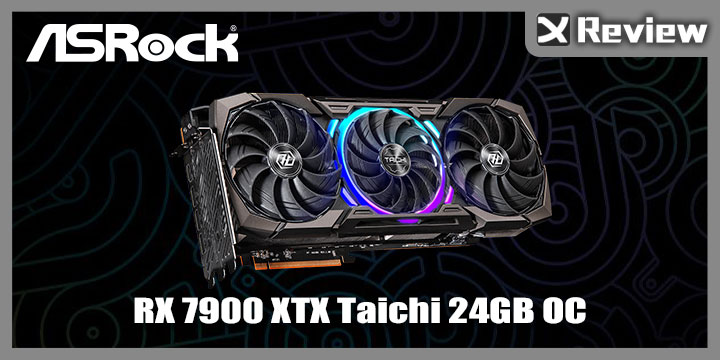The new generation giant Taichi ASRock RX 7900 XTX Taichi 24GB OC graphics card has a large volume with a length of 34cm and a width of 3-Slot. It is equipped with two 110mm and one 100mm triple fans, copper bottom, heat pipe and thickened fins for heat dissipation It is a super crazy flagship with OC 2680MHz and 22-phase power supply for GPU, giving players powerful 4K, 100FPS game performance and excellent heat dissipation performance.
Specification
Graphics core: AMD Radeon RX 7900 XTX
Bus specification: PCIe 4.0 x16
GPU Clock: Boost 2680 MHz, Gaming 2510 MHz
Stream Processor: 6144
Operation unit: 96
Memory: 24GB GDDR6
Memory speed: 20Gbps
Memory interface: 384-bit
Output interface: 3 x DisplayPort 2.0, 1 x HDMI 2.1
Power input: 3 x 8-pin
Recommended power supply: 1000W
Dimensions: 345 x 140 x 61mm, 3-slot
Weight: 1900g
ASRock RX 7900 XTX Taichi 24GB OC unpacking / 3 x 10cm fans violent cooling
AMD’s next-generation RDAN 3 architecture flagship Radeon RX 7900 XTX GPU adopts a chiplet design of 5nm GCD + 6nm MCD, allowing AMD to choose the correct semiconductor process technology to achieve the performance per watt goal, while upgrading the 2nd generation Infinity Cache, Ray Accelerators, and added AI Accelerators unit and dual media engine, as well as the Radiance Display engine that can fight the future.
Radeon RX 7900 XTX Taichi has 96 sets of CU computing units, 6144 SP stream processors, 96 RA optical tracing acceleration units, 192 AI acceleration units, and factory OC overclocked to 2680 MHz, and 24GB GDDR6 + 96MB Infinity Cache allows The memory bandwidth reaches 3500 GB/s.
However, under overclocking settings, Radeon RX 7900 XTX Taichi needs 3 PCIe 8-pin power supplies, and a 1000W power supply is recommended.

↑ ASRock RX 7900 XTX Taichi 24GB OC case.
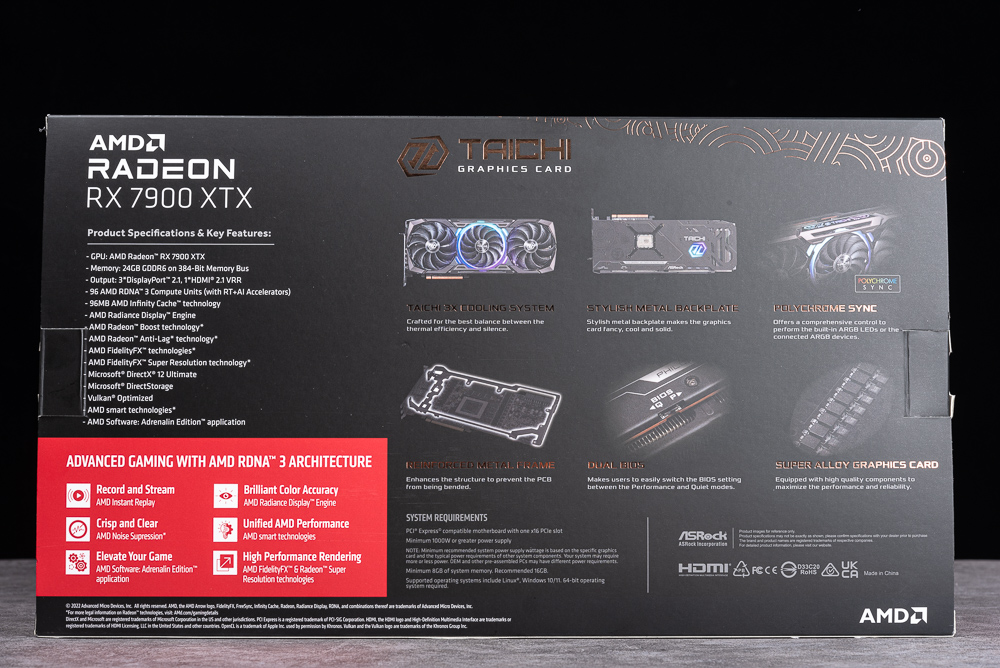
↑ There are product specifications and feature descriptions on the back.
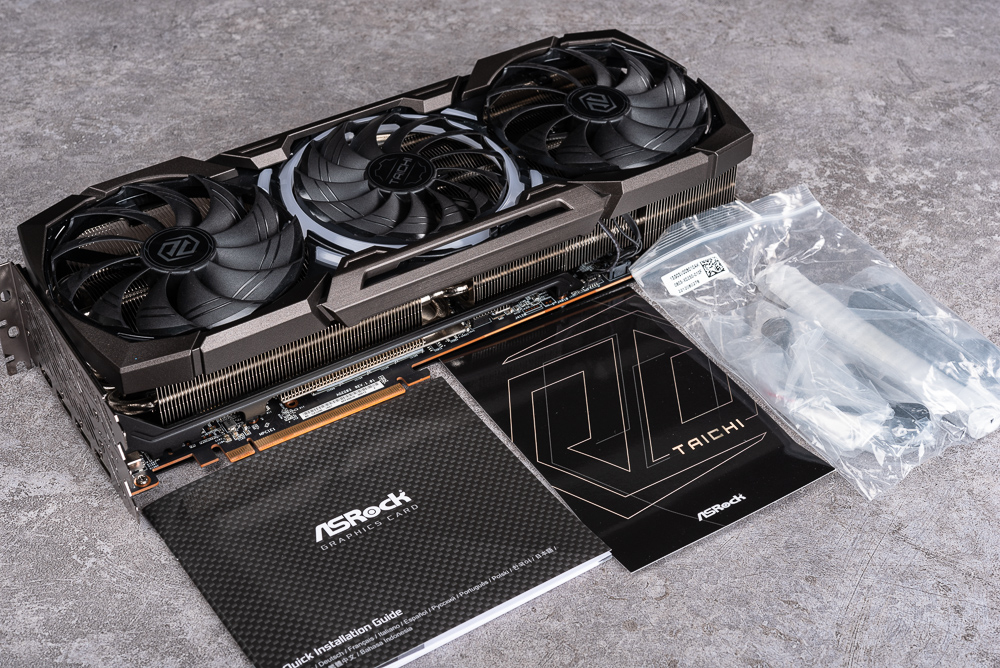
↑ Graphics card accessories include documentation and graphics card support bracket.
ASRock RX 7900 XTX Taichi accessories provide a self-assembled metal graphics card support frame, the bottom is supported by a triangular magnet, and the support frame is attached with 2 fixing buckles. When installed horizontally, it can be directly supported on the lower right of the graphics card, or directly locked in front of the graphics card. The fixed keyhole ensures that the graphics card will not cause bending problems due to gravity.
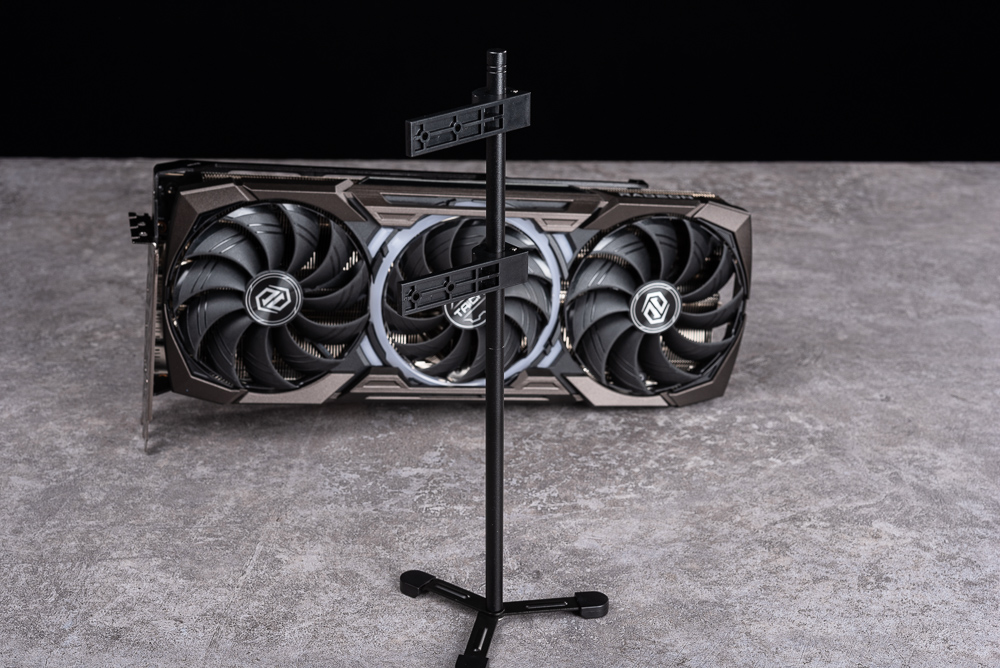
↑ Graphics card support bracket.
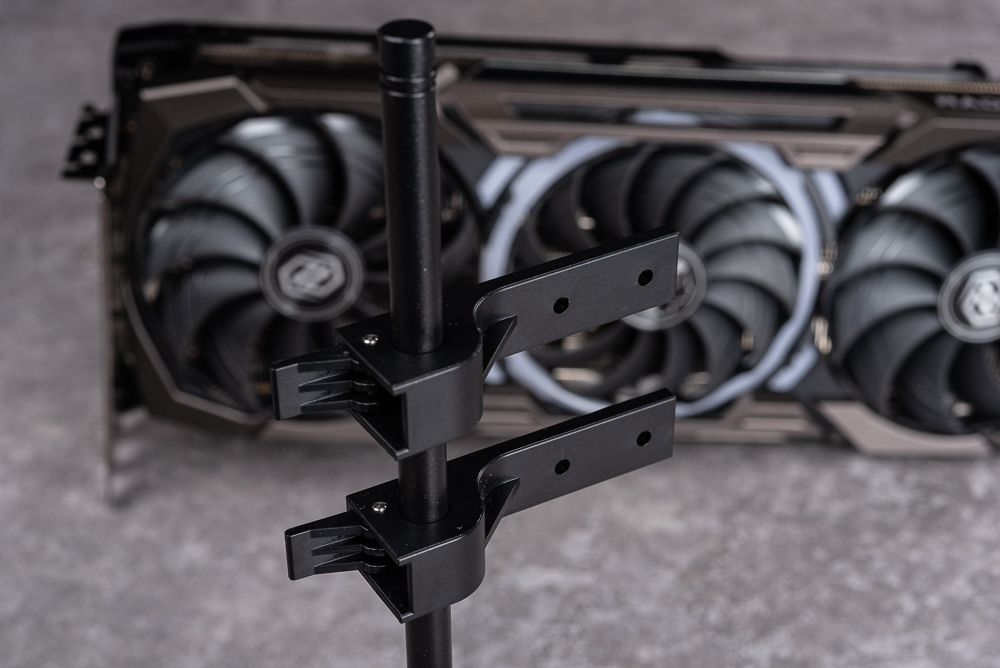
↑ There are 2 fixing buckles, and there are special fixing lock holes for the front of the graphics card.
ASRock RX 7900 XTX Taichi has a handsome and tangible armor shape. It uses 3 axial fans. The left and right two are 110mm forward and reverse fans, and the middle is 100mm. The central fan has RGB lighting effects. Domineering.
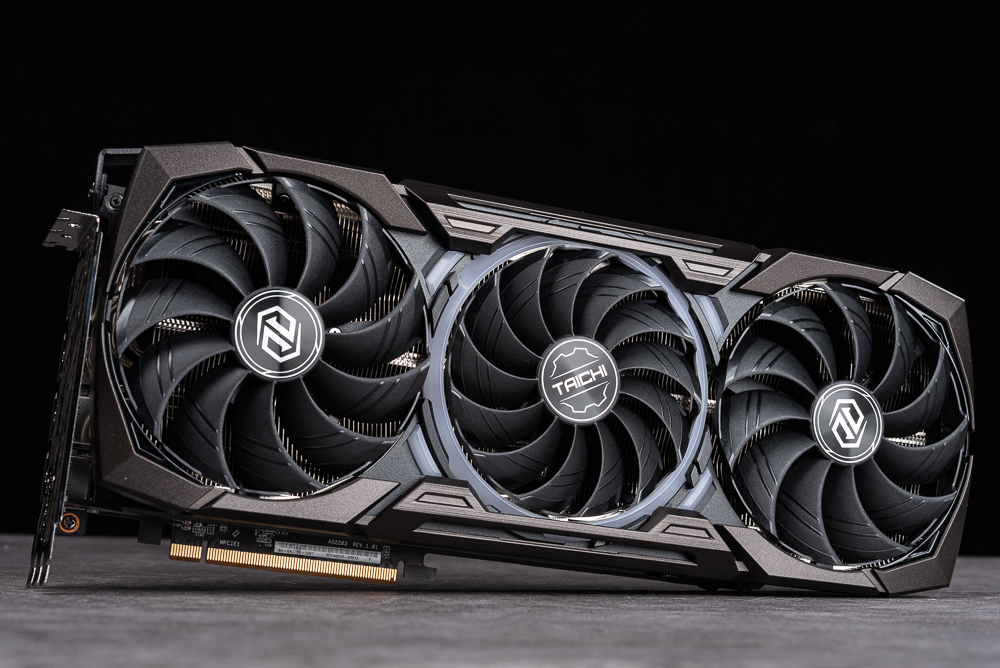
↑ ASRock RX 7900 XTX Taichi handsome armor shape and central RGB light ring.
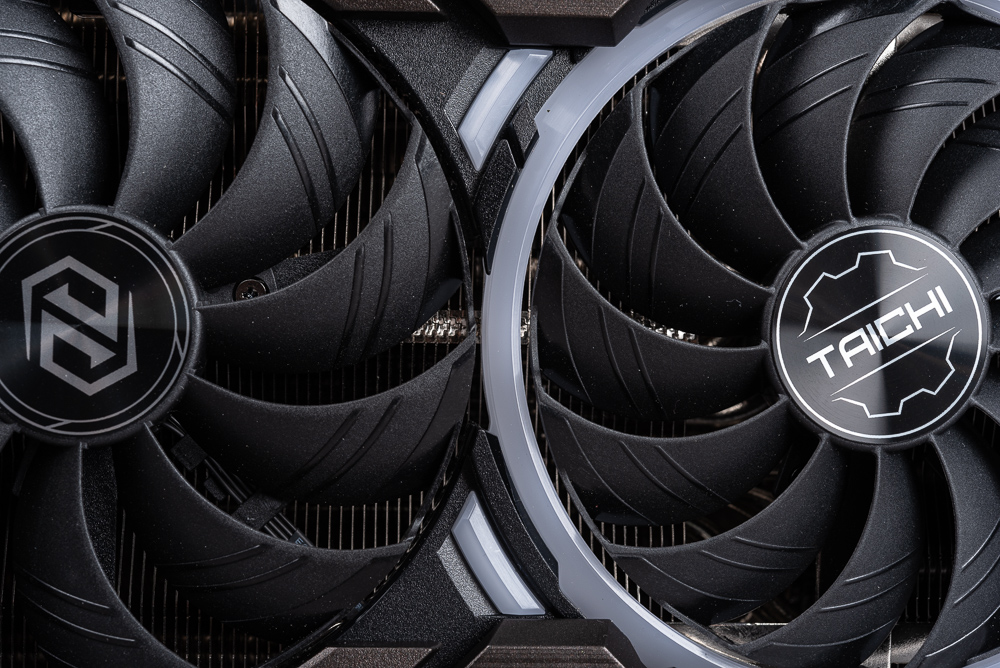
↑ Axial, forward and reverse fan configuration.
On the side of the graphics card, you can see the metal middle frame covering and a large number of cooling fins. There are RADEON words and Taichi RGB lighting effects on the side; the graphics card needs 3 PCIe 8-pin power supplies, and there is an ARGB pin next to the power socket; On the back panel of the PCIe baffle, there are switches for LED On/Off and BIOS Q/P.
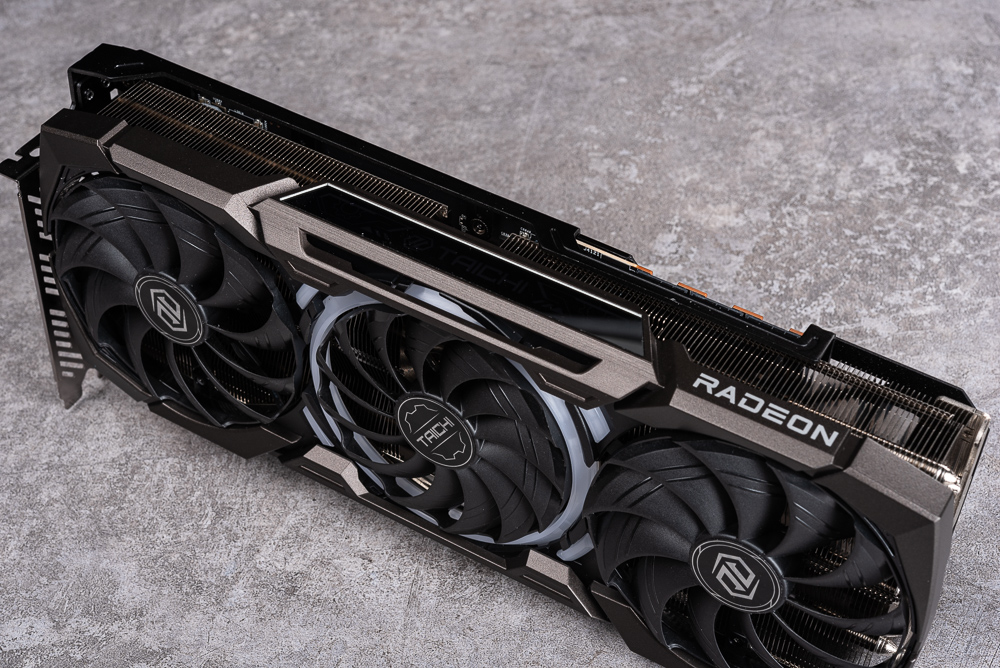
↑ The side of the domineering graphics card is more handsome after turning on the lights on the machine.
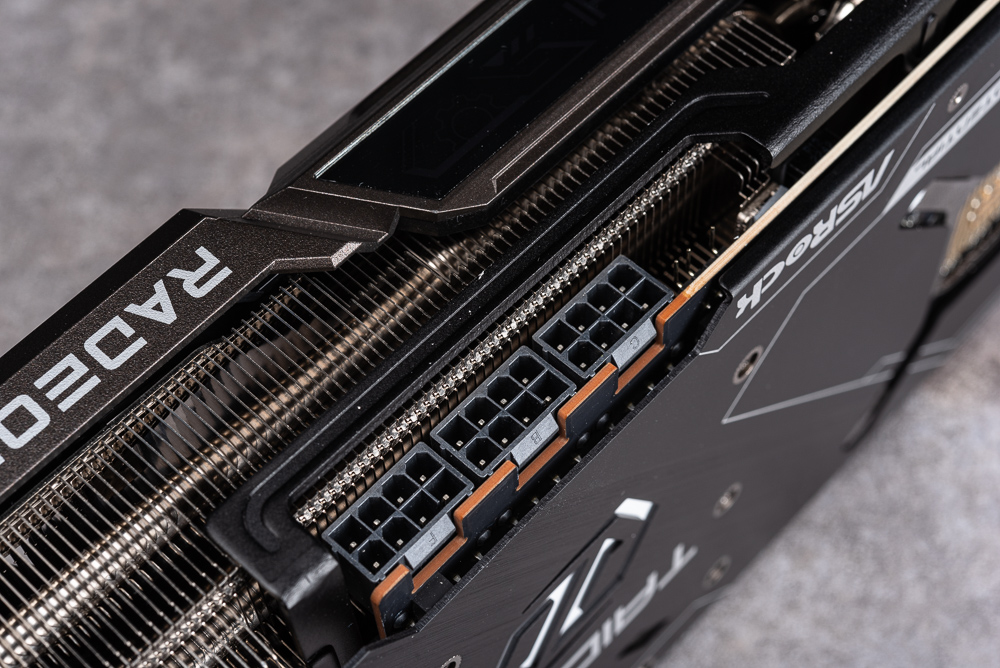
↑ Three PCIe 8-pin power supplies.
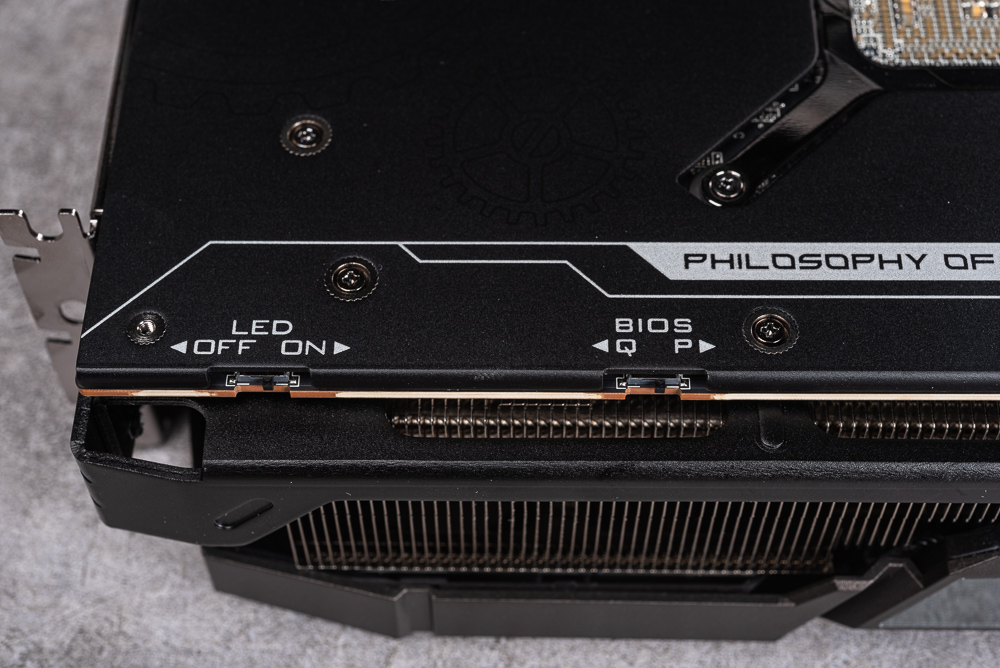
↑ LED On/Off, BIOS Q/P switch.
The ultra-thick cooling fins, V-shaped cut corners and V-shaped air holes can be seen on the front of the graphics card, which can guide the cooling airflow through the fins more efficiently.
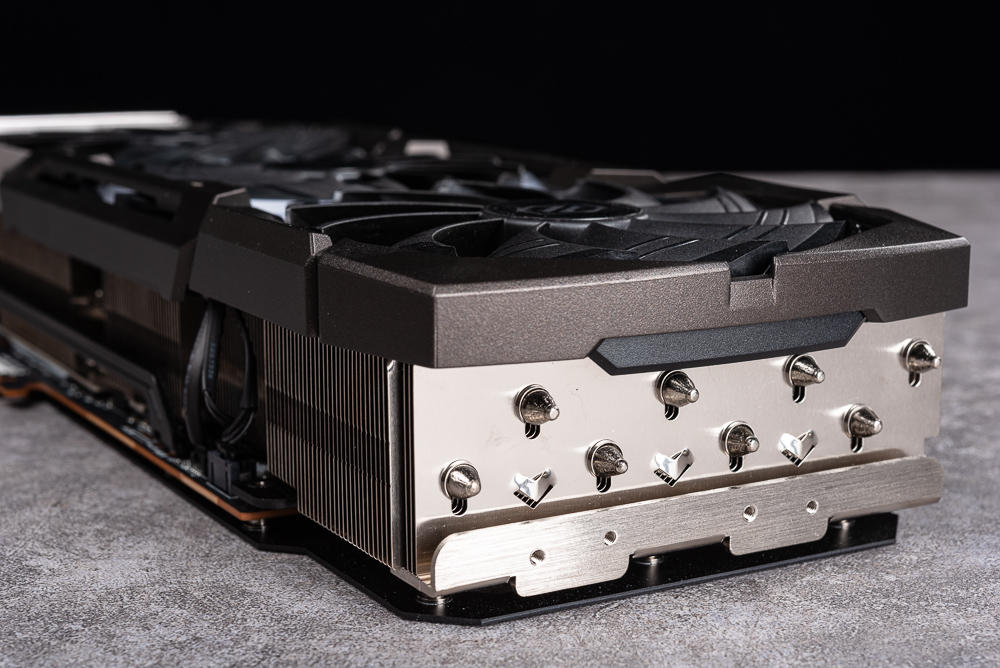
↑ V-shaped cut corners and air holes of cooling fins.
The metal back plate of the graphics card has the word TAICHI and the RGB Logo, and there are also cooling holes in the front to allow airflow to pass through the graphics card.
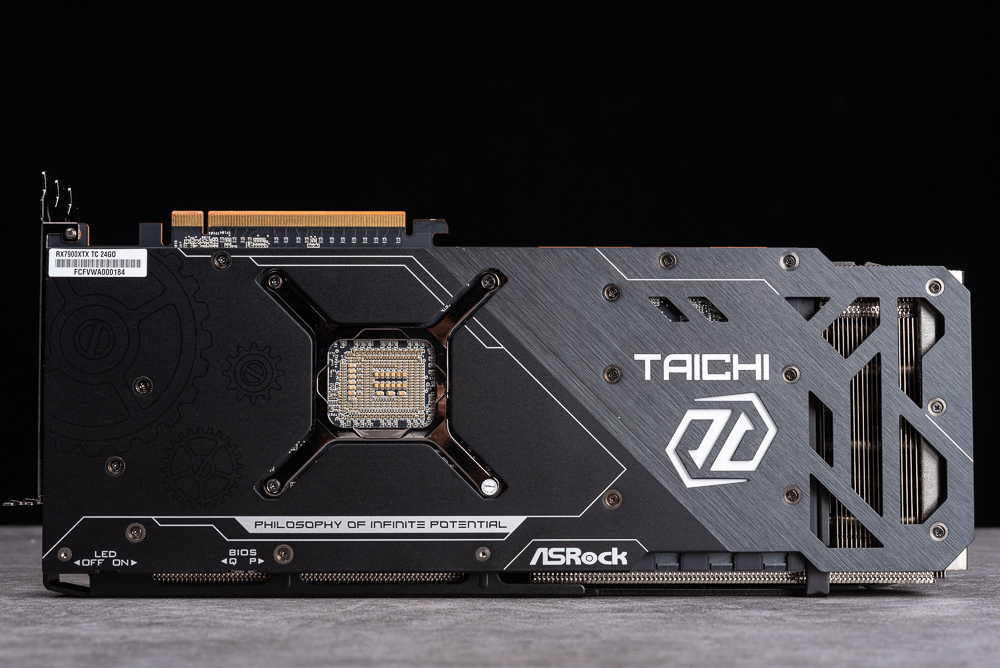
↑ Graphics card metal backplate.
The graphics card occupies a 3-Slot installation space, and the metal middle frame is also fixed with screws and baffles to enhance the overall structural strength; the graphics card can provide up to 4 screen outputs, with 3 DisplayPort 2.0 and 1 HDMI 2.1 ports.
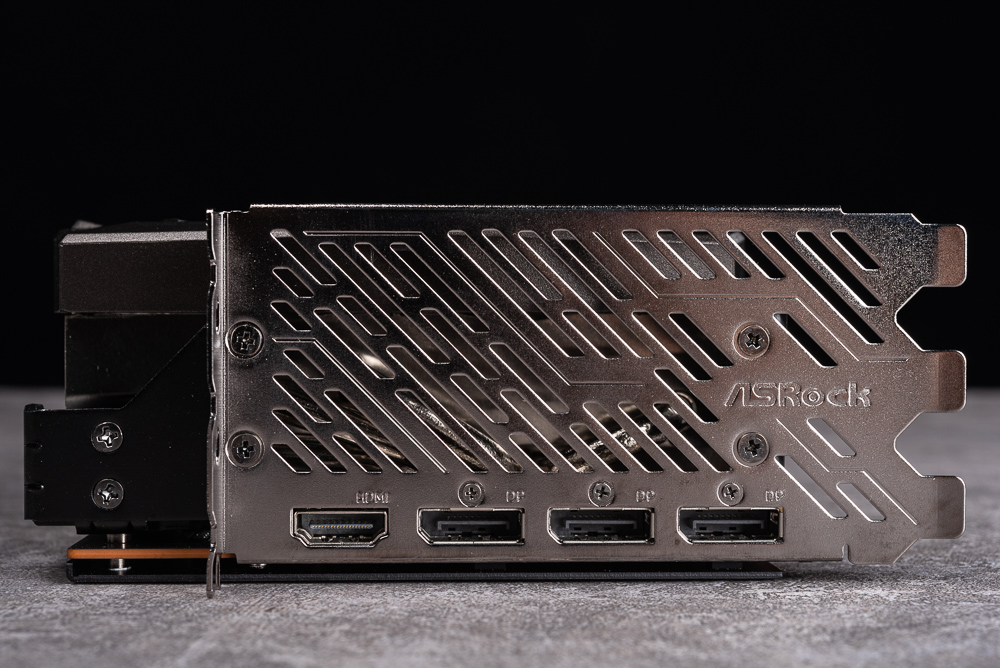
↑ Graphics card output.
When the radiator is disassembled, it can be seen that the metal middle frame strengthens the strength of the circuit board, while the radiator uses a copper bottom to directly touch the GPU, and the surrounding memory is also equipped with heat pipes for heat conduction, and the 8 heat pipes of the radiator guide the waste heat to the entire A set of heat dissipation fins, and finally 3 large fans for forced heat dissipation.
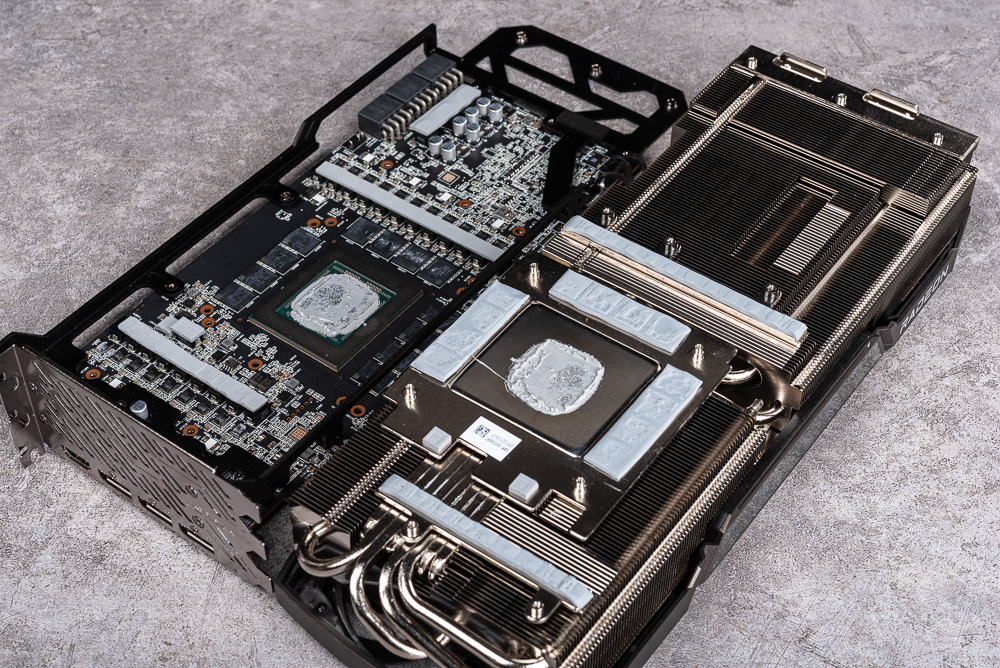
↑ The metal middle frame and heat sink on the circuit board.
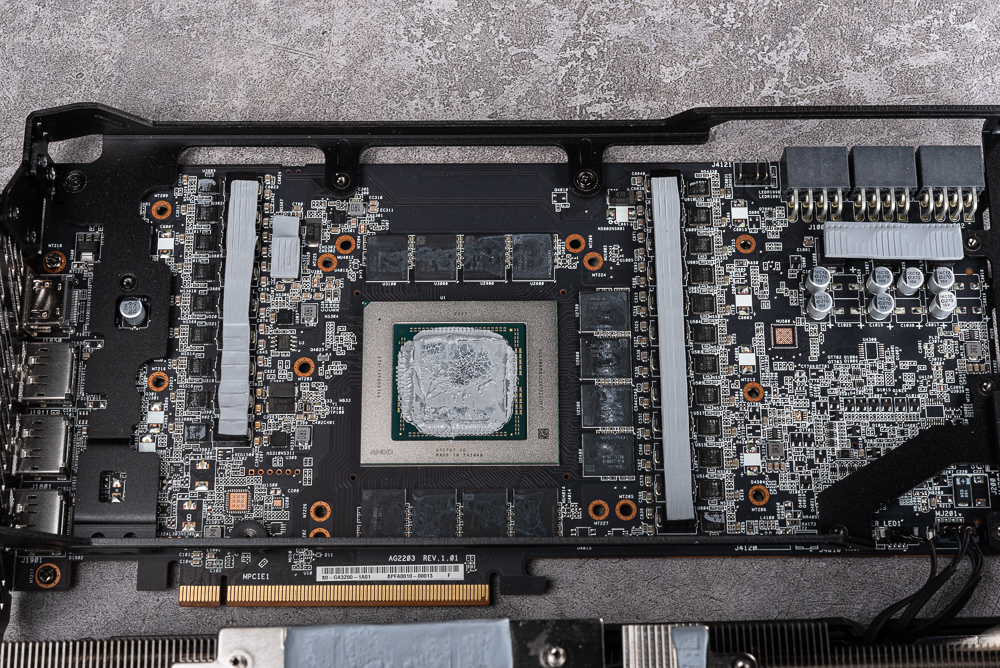
↑ RX 7900 XTX Taichi uses 22-phase power supply.
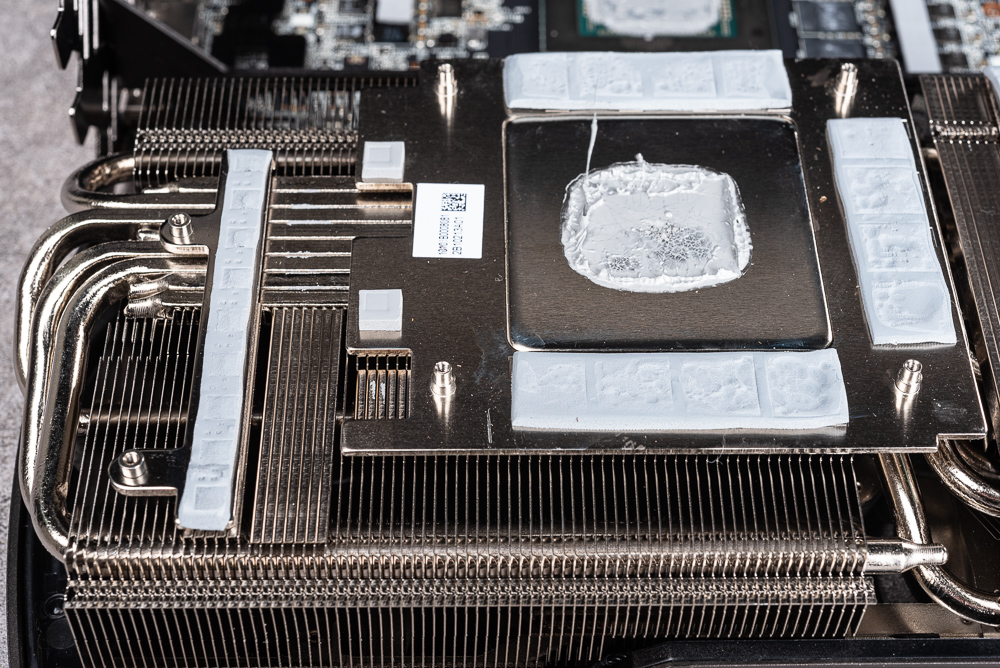
↑ The copper bottom contacts the GPU and dissipates heat for the memory, and there are 8 heat pipes and cooling fins of the radiator below.
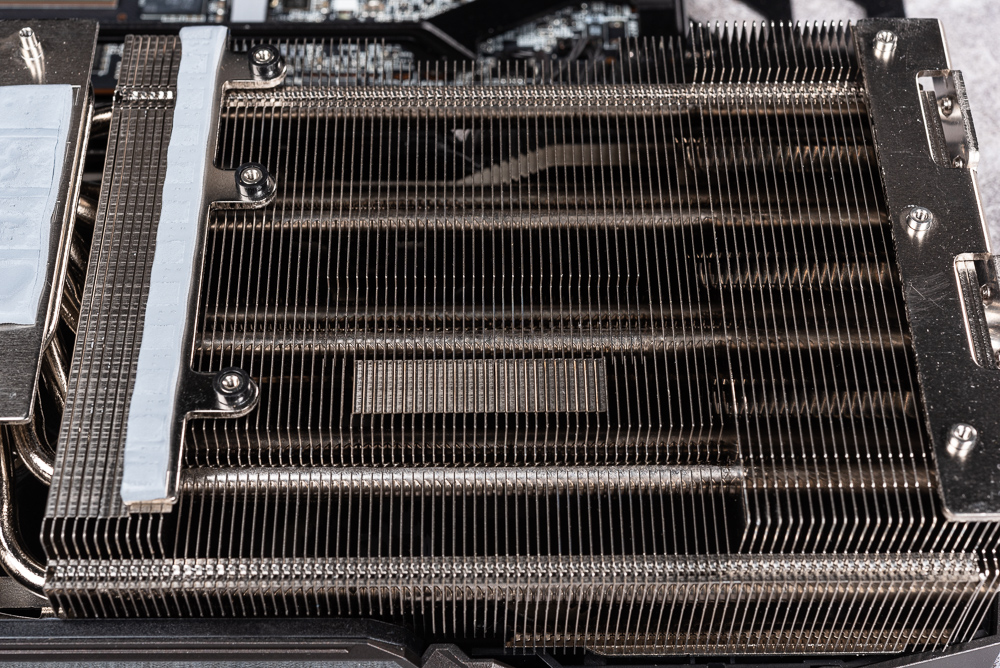
↑ Meticulous cooling fins.
The lighting effect of the graphics card is mainly on the front RGB light ring, the TAICHI light board on the side and the TAICHI Logo on the back.
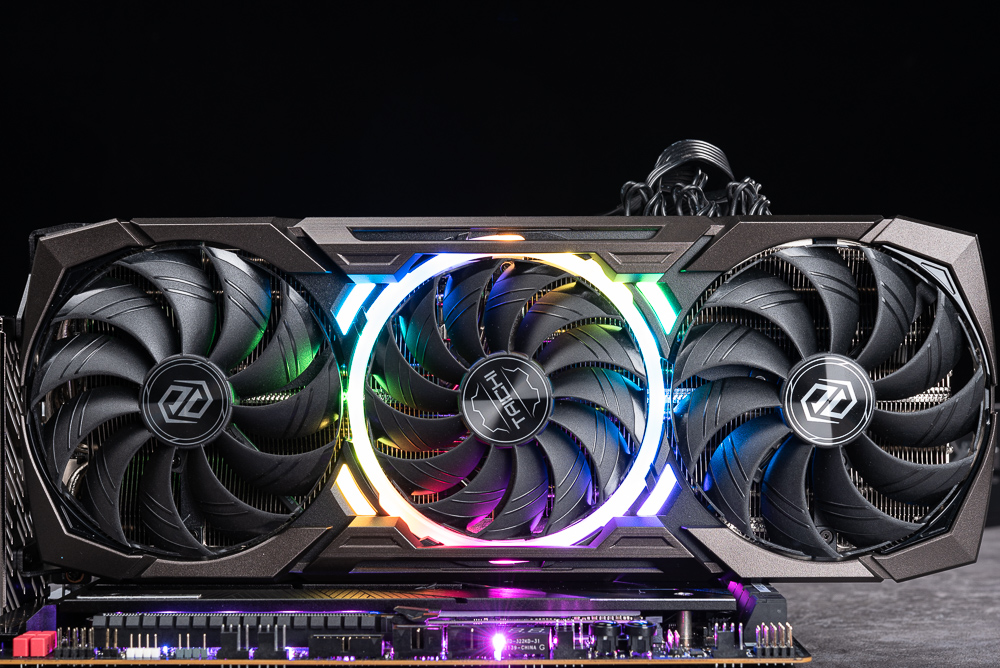
↑ Graphics card lighting effects.
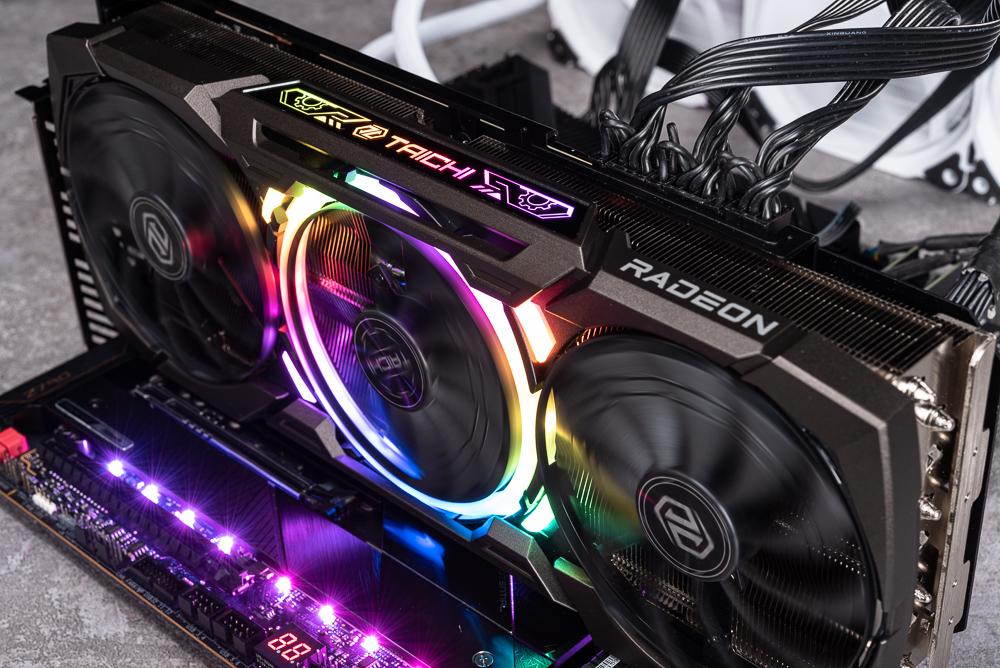
↑ Graphics card lighting effects.
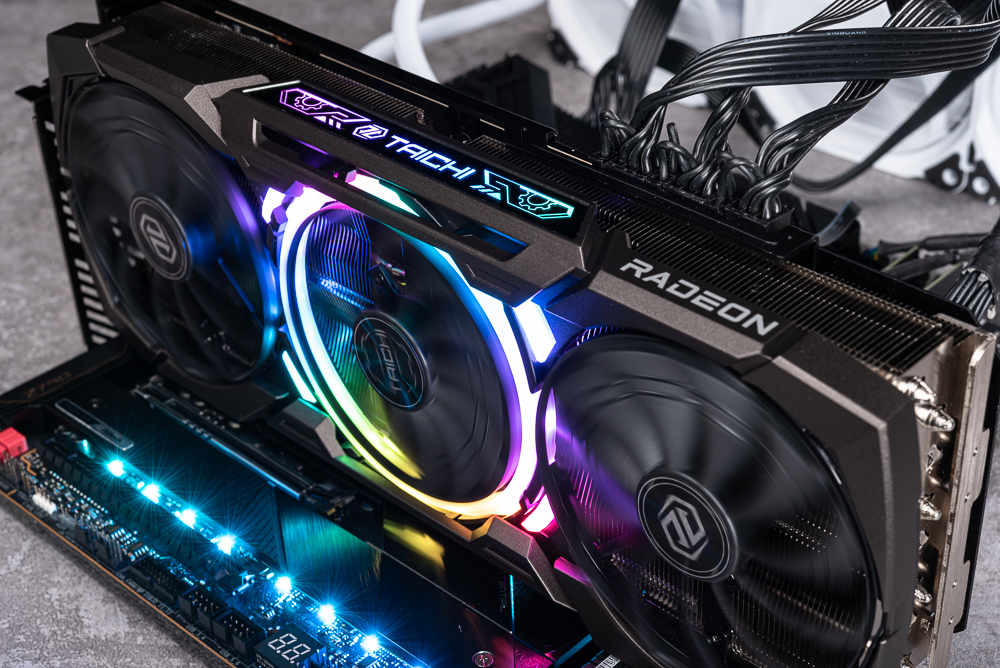
↑ Graphics card lighting effects.
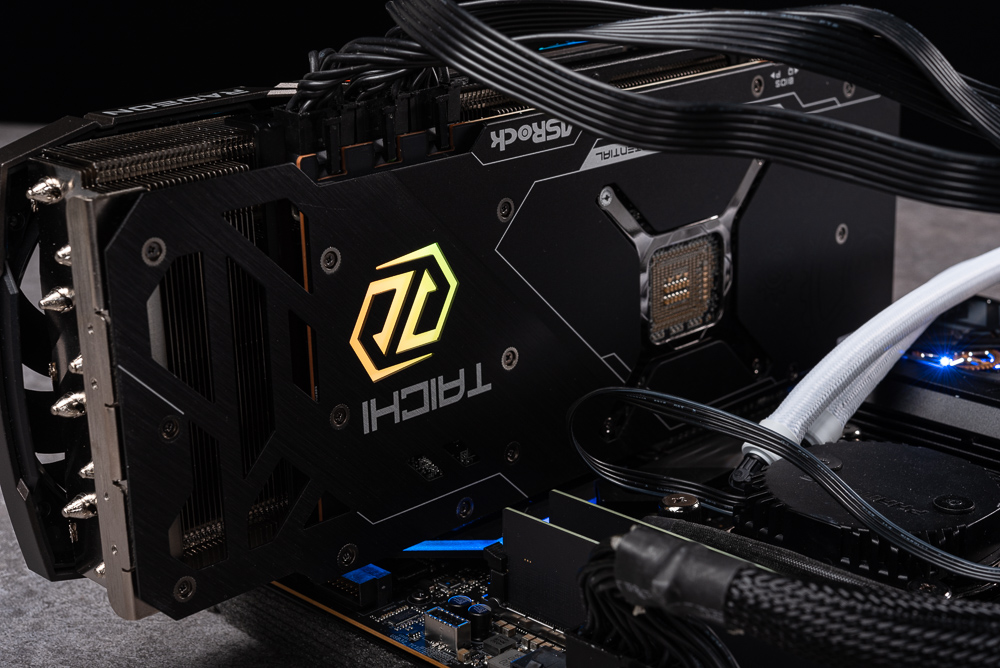
↑ Graphics card lighting effects.
ASRock Tweak overclocking tool and Polychrome Sync lighting effect software
The ASRock RX 7900 XTX Taichi graphics card has a factory OC setting, but it needs to be switched to OC Mode through the ASRock Tweak overclocking tool, and then it can be automatically overclocked to a high frequency of 2680 MHz. In addition, the software also provides default, Silent Mode and manual adjustment by players and other modes.
Simply put, the OC mode power limit is increased by 10% up to 372W, the default is 339W, and Silent is -6% 318W; while the manual adjustment mode can adjust the GPU and memory clock, fan speed and GPU power consumption limit.
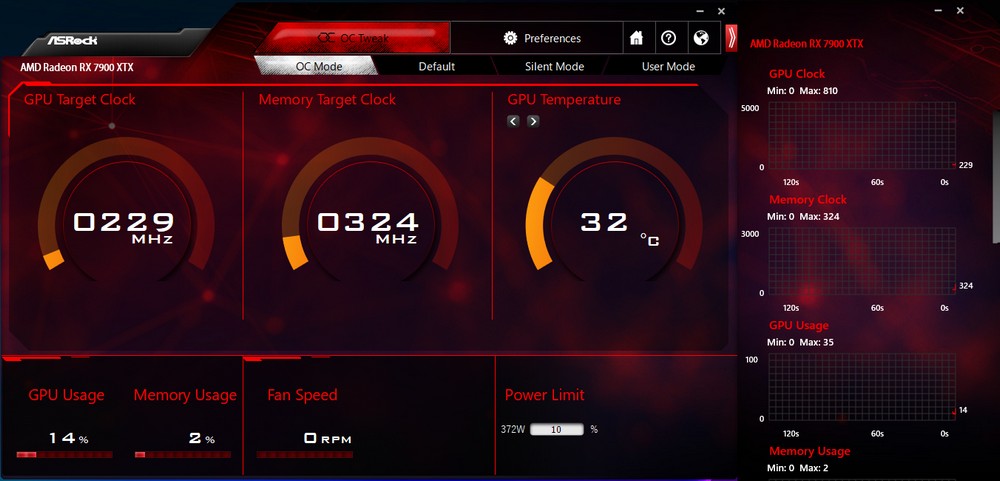
↑ ASRock Tweak。
In terms of lighting effects, the front central fan of the RX 7900 XTX Taichi graphics card, the Taichi light board on the side, the Taichi Logo on the back panel, and the ARGB pins provided by the graphics card can all be adjusted and synchronized through the ASRock Polychrome Sync software.
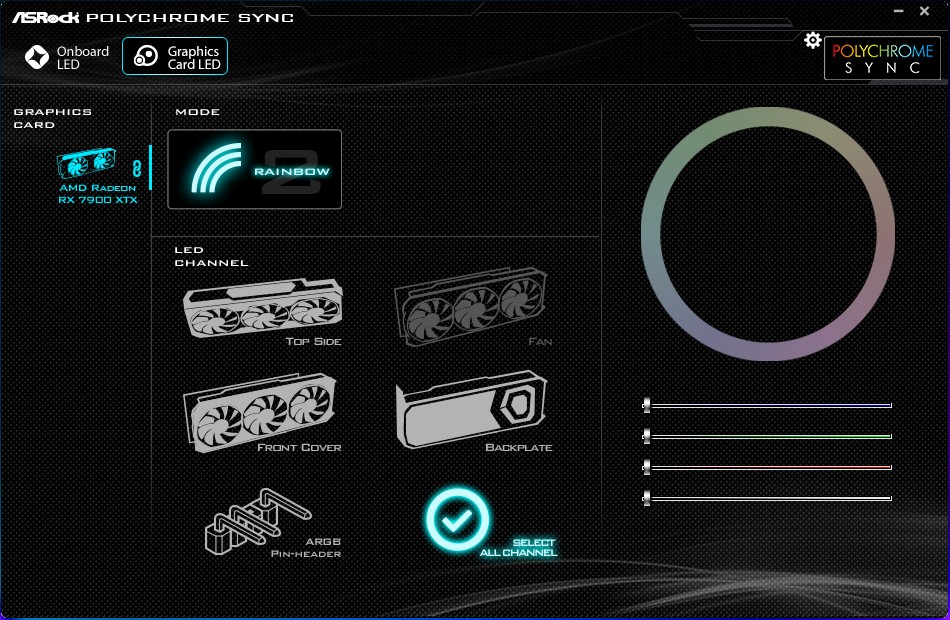
↑ ASRock Polychrome Sync。
ASRock RX 7900 XTX Taichi 24GB OC Benchmark Performance Test
The graphics card performance test uses Intel Core i9-13900K, ASRock Z790 Taichi and dual-channel DDR5 16GB*2-7000 memory, and the Resizable Bar function is turned on to conduct 3DMark, 2160p gaming, AAA games and DXR game tests.
testing platform
Processor: Intel Core i9-13900K
Motherboard: ASRock Z790 Taichi
Memory: KLEVV DDR5-7000 16GBx2
Graphics card: ASRock RX 7900 XTX Taichi 24GB OC
System drive: Solidigm P41 Plus 1TB PCIe 4.0 SSD
Radiator: Phanteks Glacier One 360MPH
Power supply: Seasonic VERTEX GX-1000
Operating system: Windows 11 Pro 22H2 64bit, Resizable BAR On
Driver version: AMD 23.1.1
GPU-Z View the information of ASRock RX 7900 XTX Taichi 24GB OC, which uses 5nm process Navi 31 GPU, has 6144 rendering cores, and 24576 MB GDDR6 memory, and the GPU default clock frequency is 2526 MHz, Boost 2679 MHz, and the graphics card uses PCIe 4.0 x16 Interface bandwidth, the driver version is 23.1.1, and Resizable BAR is enabled.
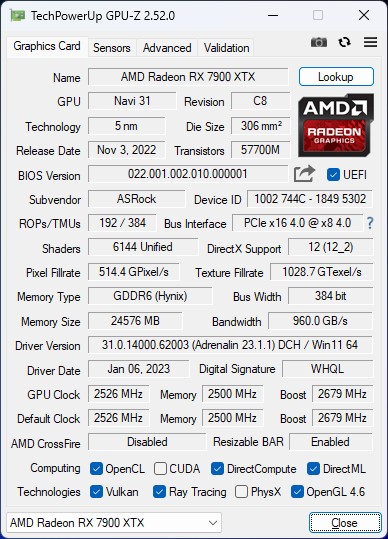
↑ GPU-Z。
3DMark Fire Strike In the performance test, the mainstream 1080p resolution and DirectX 11 API test scenario, the RX 7900 XTX Taichi scored 44,901 points, while the 1440p Extreme scored 35,144 points, and the Ultra test with a higher 4K 2160p resolution scored 21,113 points; In the Extreme and Ultra tests, they were rated as Good and Great (higher than the average).
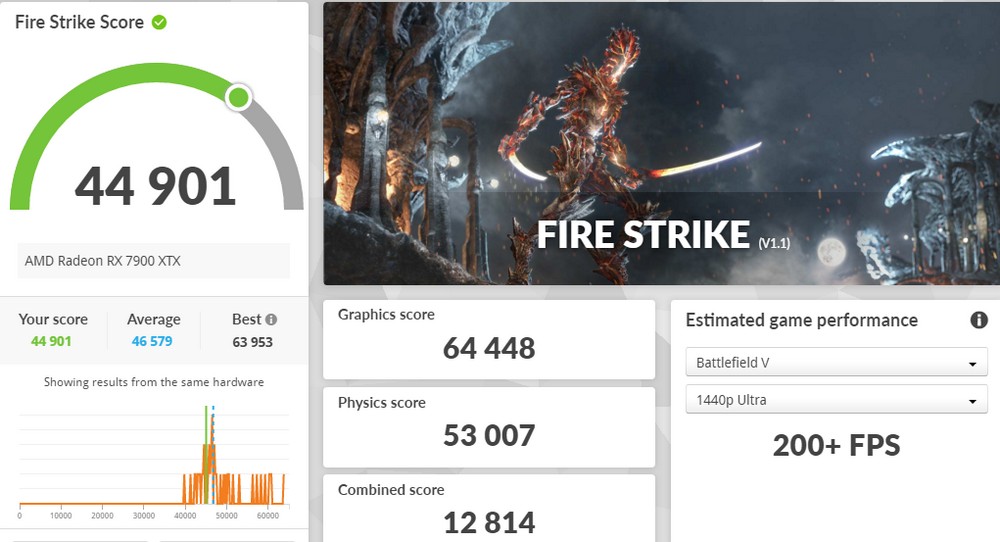
↑ 3DMark Fire Strike。
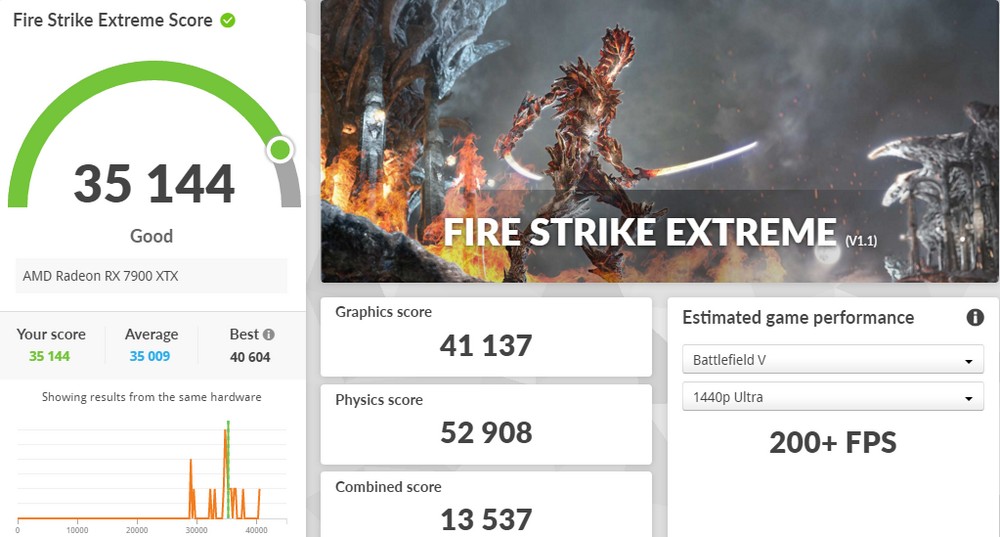
↑ 3DMark Fire Strike Extreme。
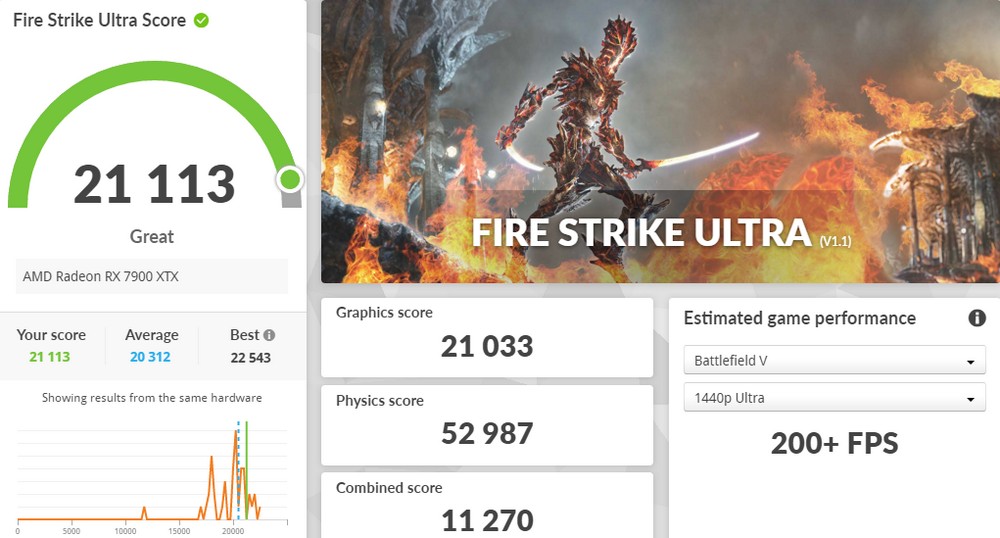
↑ 3DMark Fire Strike Ultra。
3DMark Time Spy It is a test scenario designed using DirectX 12 API, which is also locked in the AAA game level. On the 1440p Time Spy test, the RX 7900 XTX Taichi scored 28,984 points, while the Extreme scored 15,345 points, which were rated Great and Good respectively.
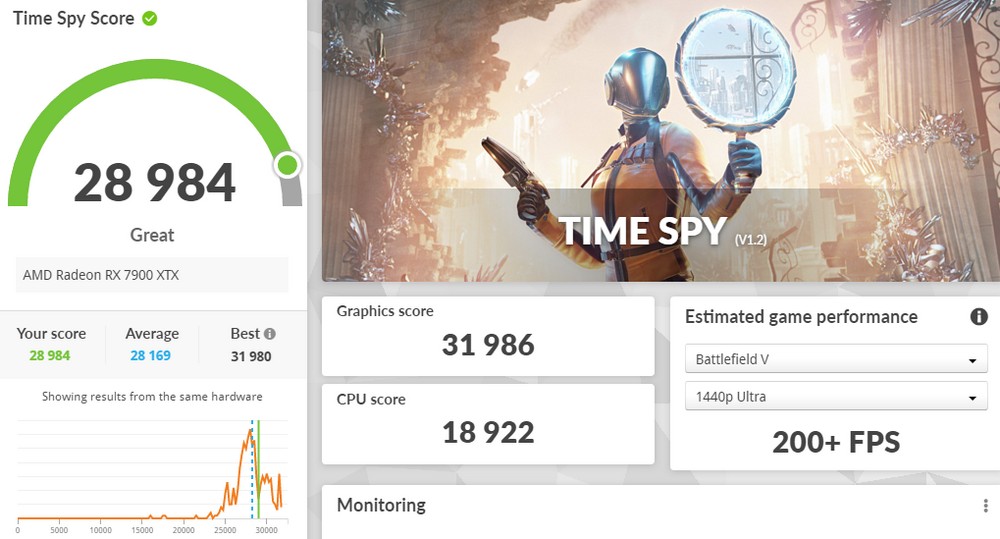
↑ 3DMark Time Spy。
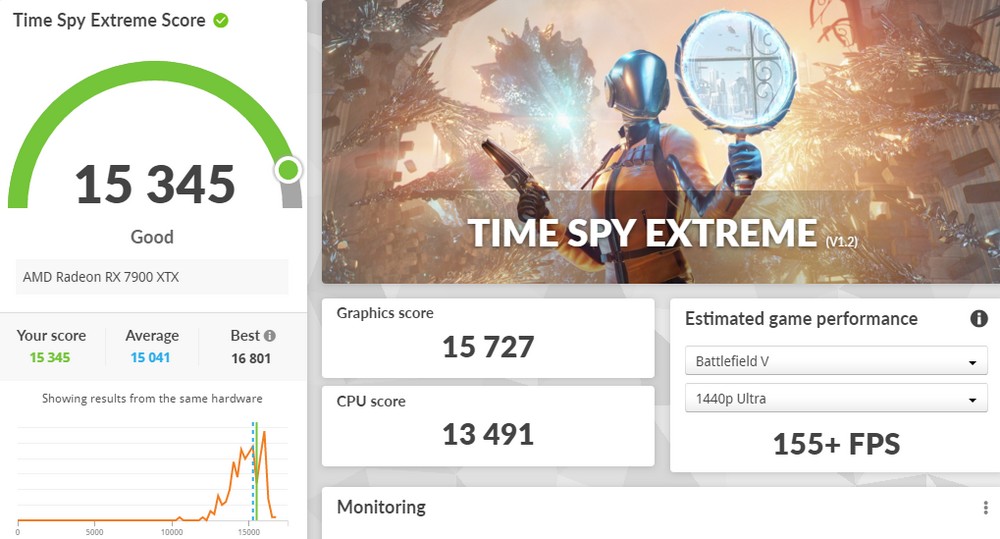
↑ 3DMark Time Spy Extreme。
for ray tracing tests 3DMark Port Royal Adding technologies such as light-chasing DXR applications to scenes in AAA games, the RX 7900 XTX Taichi achieved 16777 points of Good scores and an average of 77.68 FPS.And the last new Speed Way In the test developed with full ray tracing, the score reached 6261 points Good score, with an average of 62.61 FPS.
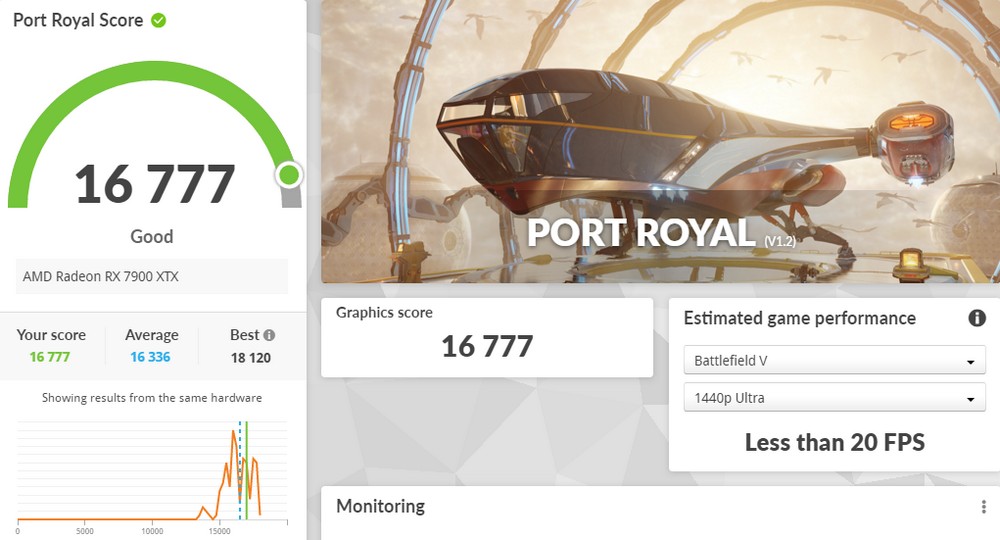
↑ 3DMark Port Royal。
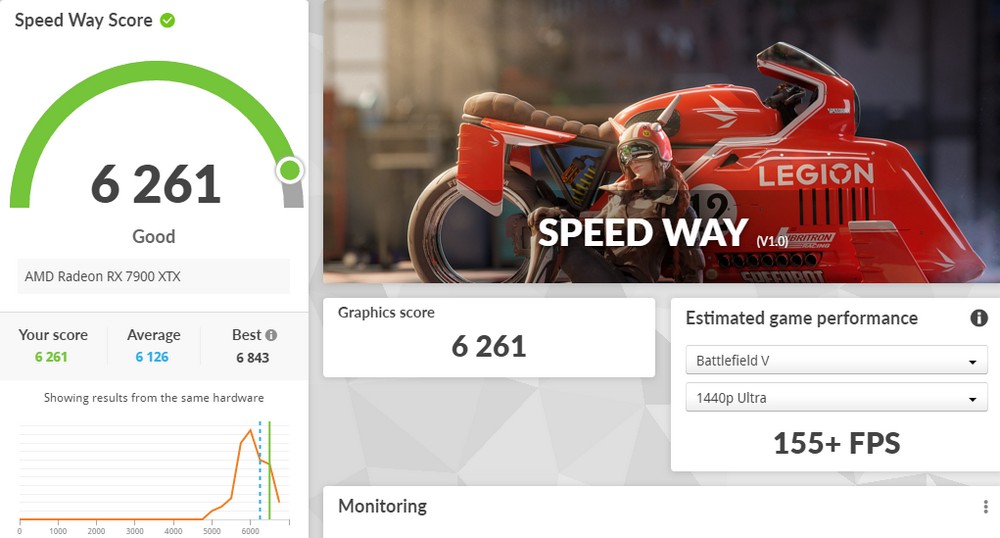
↑ 3DMark Speed Way。
ASRock RX 7900 XTX Taichi 24GB OC – 4 gaming games performance test
4 eSports games“Rainbow Six: Siege”, “League of Legends”, “APEX Heroes” and “CS:GO”, etc., are all skills-heavy, team tactical competitive shooting, and DOTA-type games, so the game quality and details are not high. Under normal circumstances, the game FPS is also an average performance of more than 100 frames.
RX 7900 XTX Taichi has quite good performance in 2160p resolution e-sports games, “CS:GO” averages 404.35 FPS, “APEX Heroes” averages 193 FPS, “League of Legends” averages 447 FPS, “Rainbow Six: Siege Action” has an average of 429 FPS, and its performance can definitely meet the high FPS gaming experience required by e-sports games.
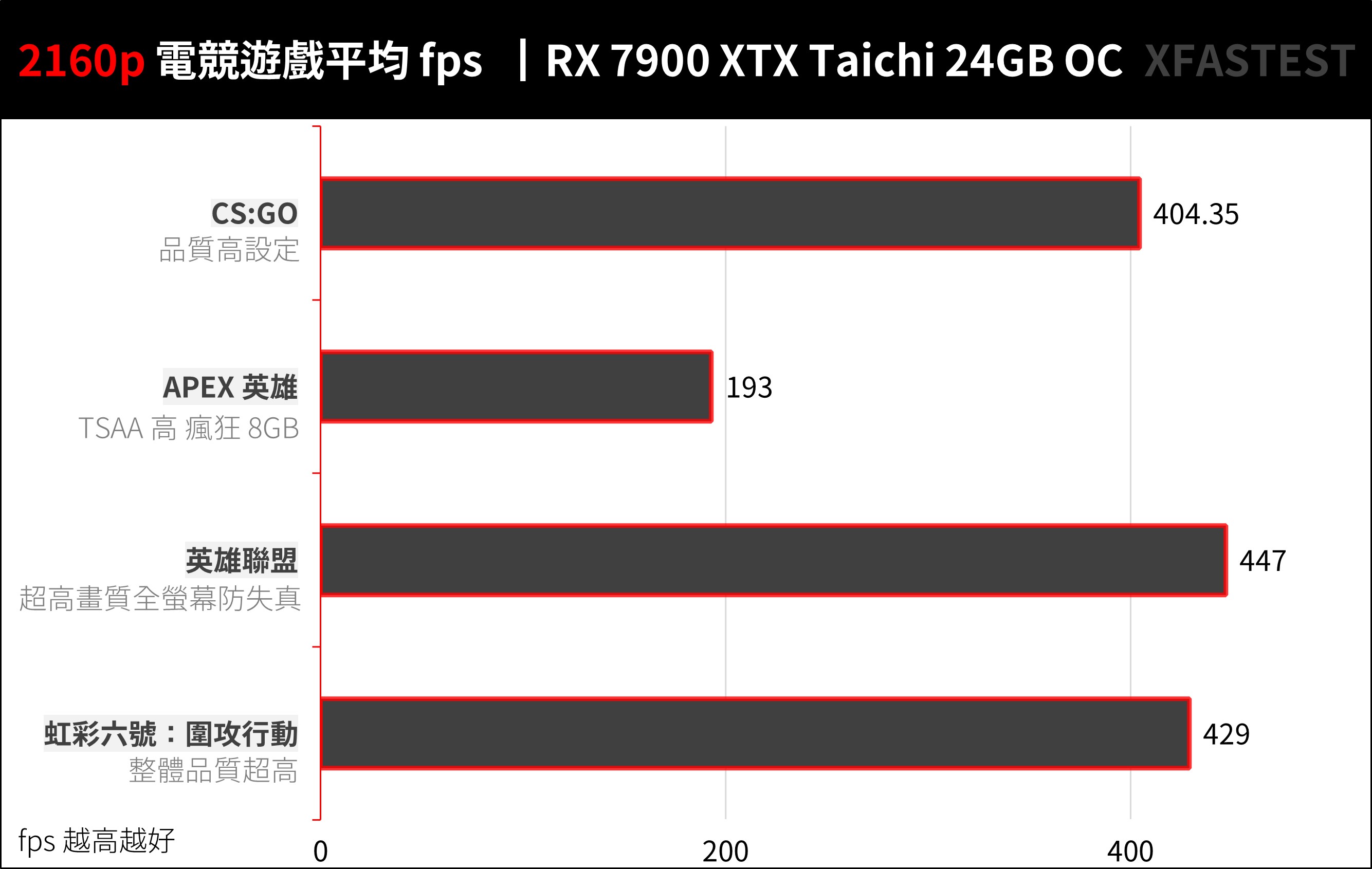
↑ 4 e-sports game tests, the higher the FPS, the better.
ASRock RX 7900 XTX Taichi 24GB OC – 11 Games Benchmark
11 AAA gamesThe average performance is tested at 2160p with full special effects. In this test, only F1 2021 uses the ray tracing function, and the other games have no ray tracing and no acceleration settings to test the actual traditional rendering game performance of the GPU.
The game test list includes the entry-level “F1 2021”, “Forza Horizon 5” racing game, “Tomb Raider: Shadow”, movie game “Death Stranding”, “Gears of War 5”, “The Division 2″, ” Horizon: Waiting for Dawn, as well as tests such as “Borderland 3”, “Assassin’s Creed: Viking Age”, “Blood Killing 2” and “God of War” that are heavy on performance.
The RX 7900 XTX Taichi reached an average of 118.75 FPS in 2160p and AAA games. All games have sufficient game performance, and only “Blood Killing 2” is below 100 FPS.
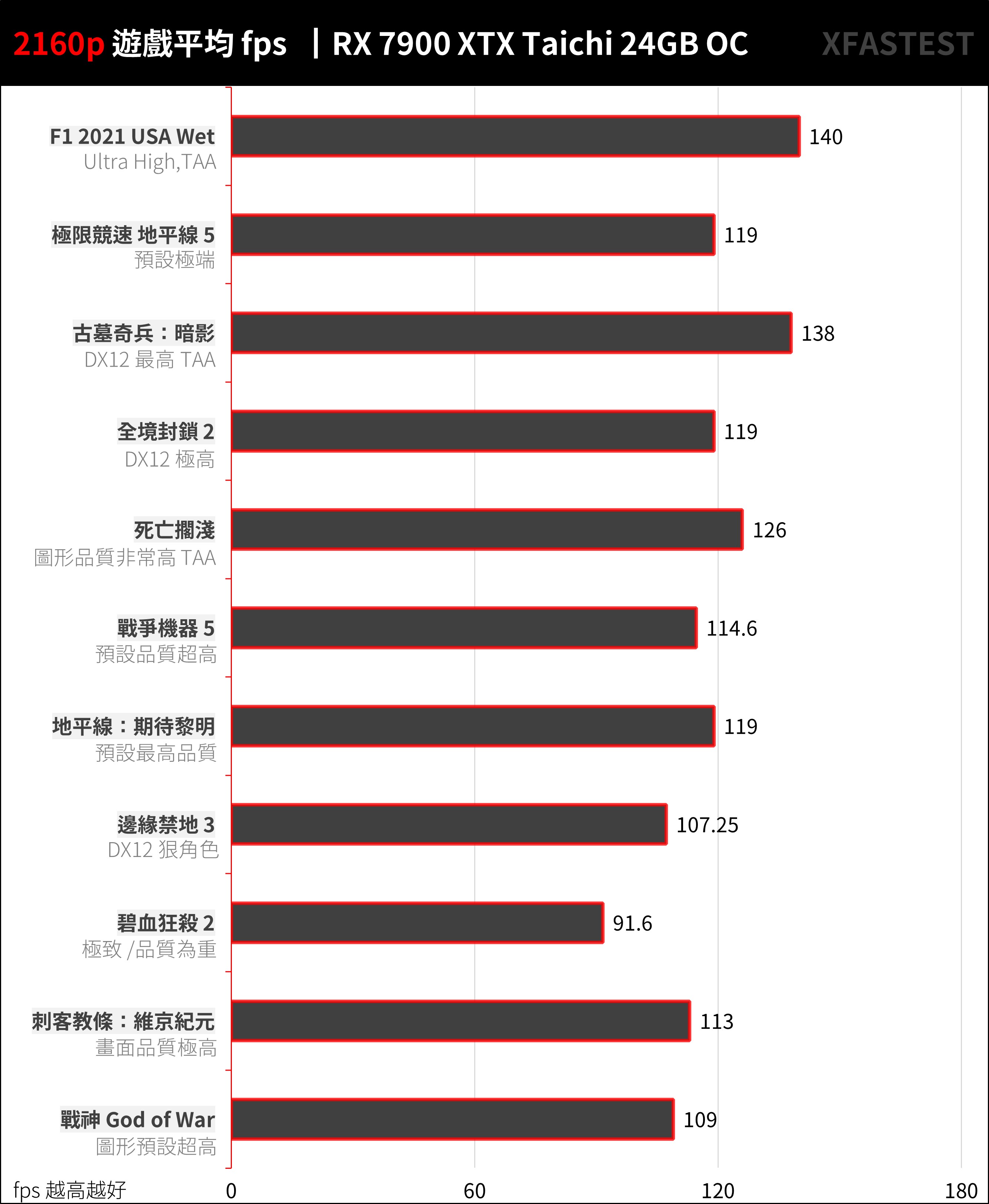
↑ 11 AAA game tests, the higher the FPS, the better.
ASRock RX 7900 XTX Taichi 24GB OC – 9 ray chasing game tests
9 Light Tracing DXR GamesFor the test, use the next-generation update “The Witcher 3: Wild Hunt”, the most popular “Dian Yu Ren Ke 2077”, “Watch Dogs: Freedom Legion”, “Evil Castle Village”, “Marvel Spider-Man: Miles Moraes, Marvel Star Trek, Forspoken, F1® 22, and Far Cry 6. Test 2160p resolution, special effects/ray tracing highest setting, FSR acceleration will also be enabled, please refer to the chart for detailed settings.
RX 7900 XTX Taichi can achieve an average of 101.9 FPS in 2160p light-chasing games, “F1® 22” averages 132 FPS, “Evil Castle Village” averages 202 FPS, and “Marvel Spider-Man: Miles Moras” averages 99 FPS, which has enough light-tracing performance, but compared to the average 57.4 FPS of “Dian Yu Ren Ke 2077” and the average 57 FPS of “The Witcher 3: Wild Hunt”, the special effect settings need to be slightly reduced.
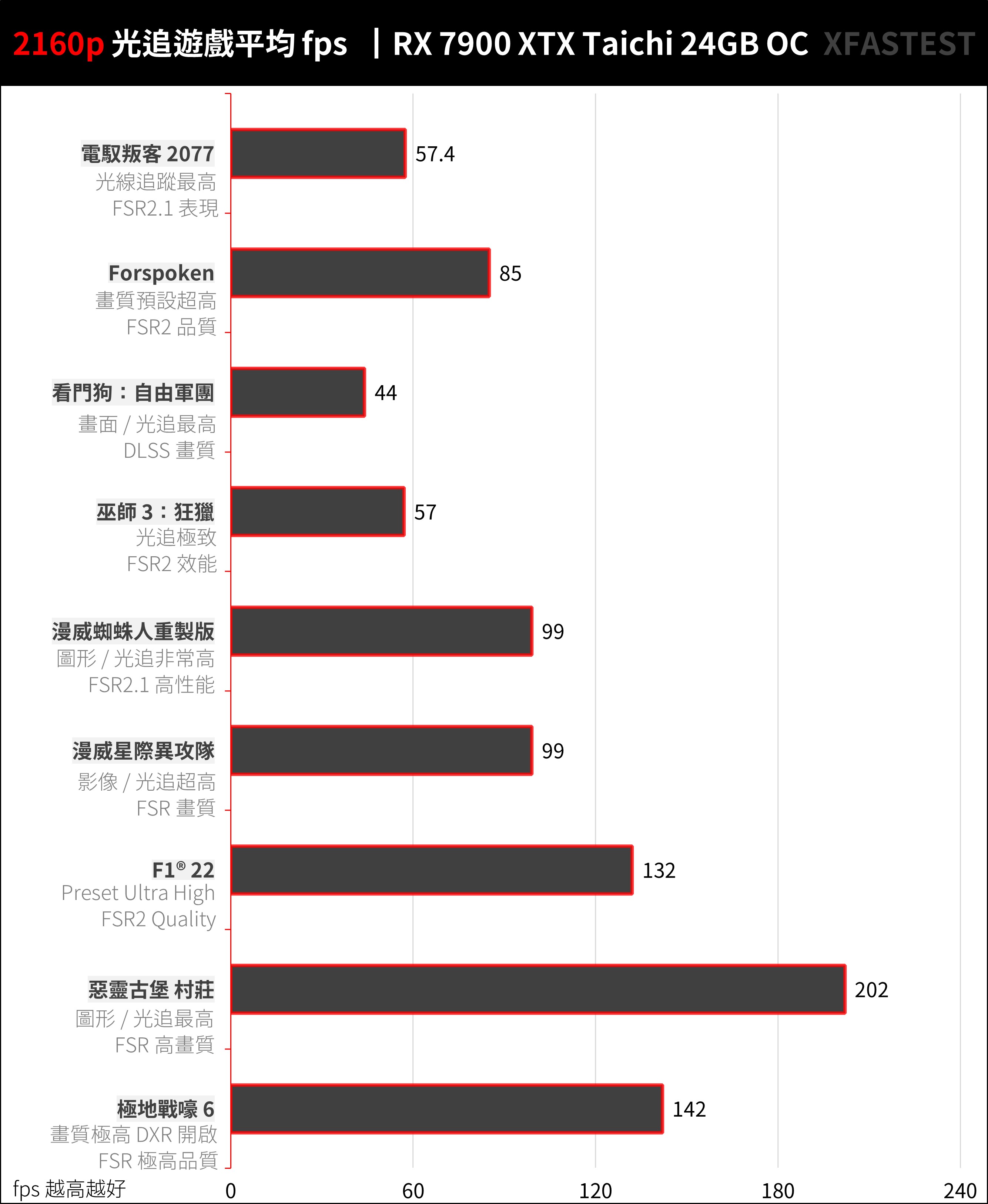
↑ 9 light-chasing game tests, the higher the FPS, the better.
ASRock RX 7900 XTX Taichi 24GB OC power consumption and temperature measurement
The power consumption and temperature test of the graphics card is tested using Time Spy Stress test, Furmark and “Dian Yu Ren Ke 2077”. When measuring power consumption, use the PACT tool provided by NVIDIA to monitor the wattage provided by the PCIe slot and the power supply 12V.
In terms of graphics card temperature, the highest temperature of the RX 7900 XTX Taichi stress test is maintained at 61°C, and the overall temperature suppression performance can be said to be quite good.
In terms of power consumption, on the contrary, the Time Spy Stress test and Furmark test are as high as 373W, and the 2077 game is 320W. It is recommended that players use a 100W power supply when installing the computer.
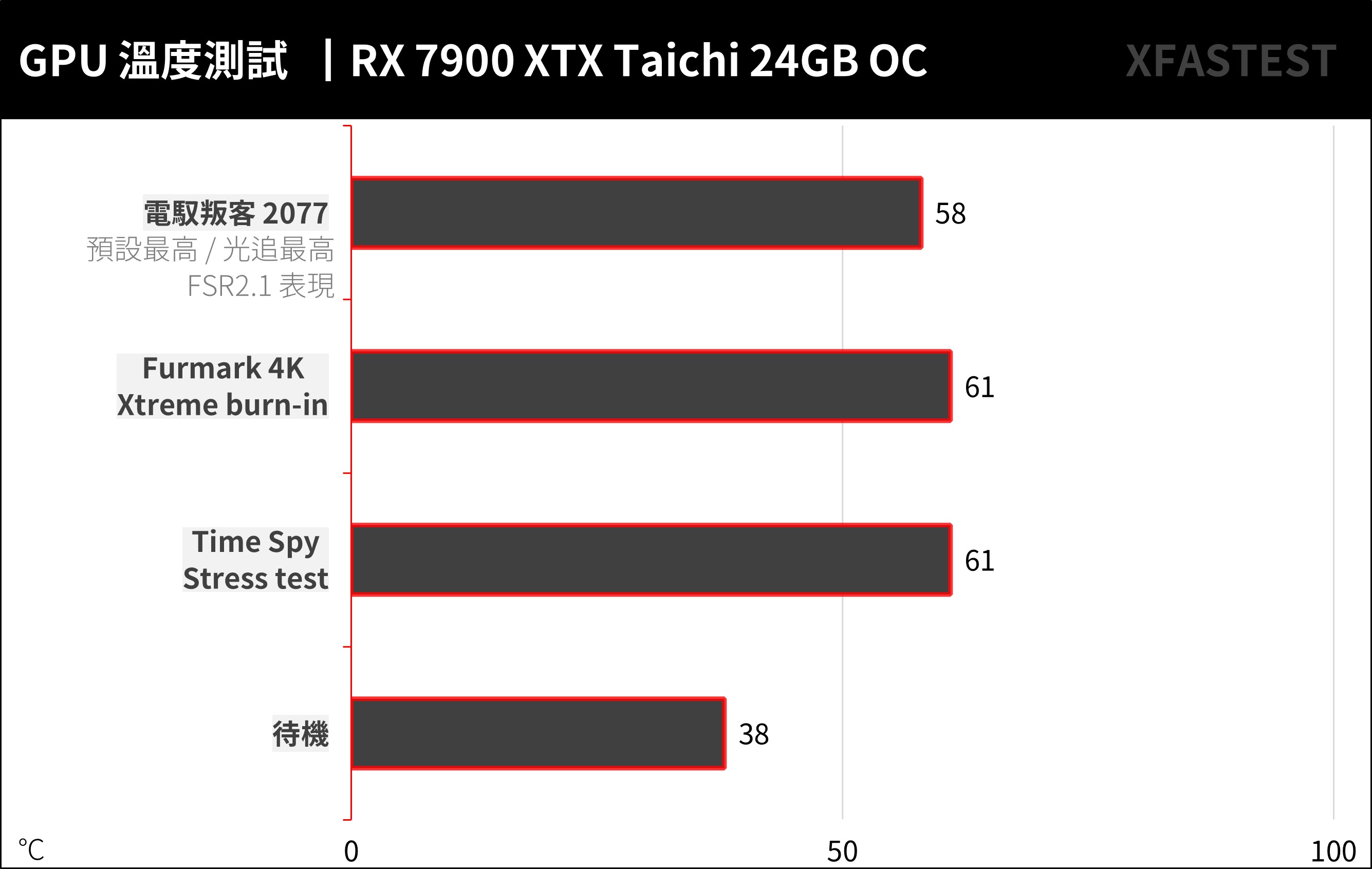
↑ Graphics card temperature test.
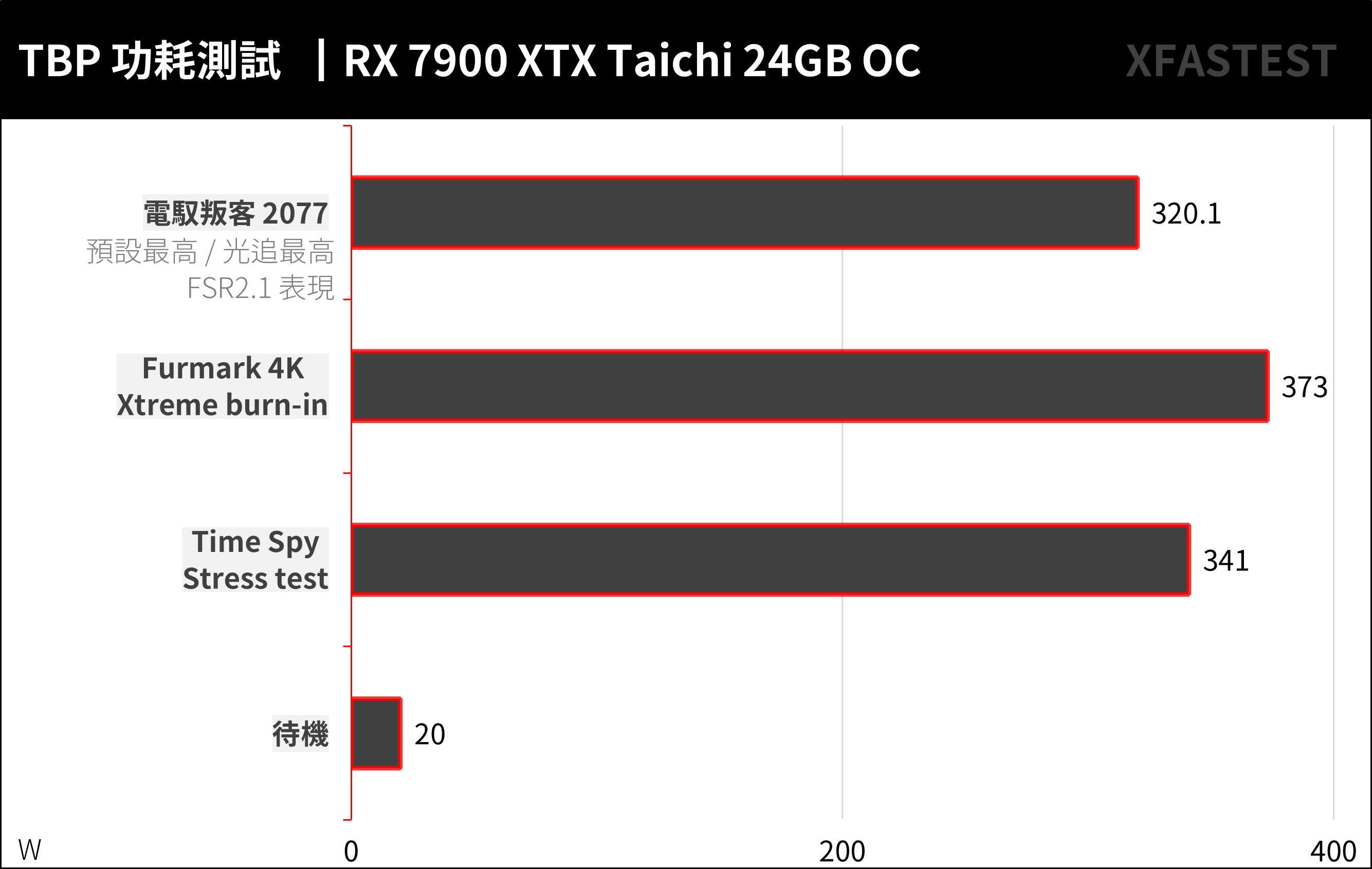
↑ Display card power consumption test.
Summarize
ASRock RX 7900 XTX Taichi 24GB OC graphics card has a handsome new shape. It adopts two 110mm and one 100mm forward and reverse axial three-fans, allowing the length of the graphics card to reach 34.5cm, but it requires a domineering 3-Slot installation space The radiator also allows the graphics card to have excellent heat dissipation performance. At the same time, it has a Polychrome RGB light ring, light panel and Logo light, showing the domineering flagship graphics card.
RX 7900 XTX Taichi can meet the performance requirements of more than 400 FPS for e-sports players. It can also reach an average of 118.75 FPS for 2160p and AAA games, and an average of 101.9 FPS for light-chasing games. It is still necessary to reduce the special effect setting slightly to stabilize the game performance at 60 FPS.
It’s just that the current AMD series of new graphics cards are quite small in stock. ASRock RX 7900 XTX Taichi also had a wave of limited assembly sales a while ago, and the price in Taiwan is $39,990. Players with sufficient budgets who want to unlock 4K, 100 FPS performance, just This one is missing.
Further reading:
